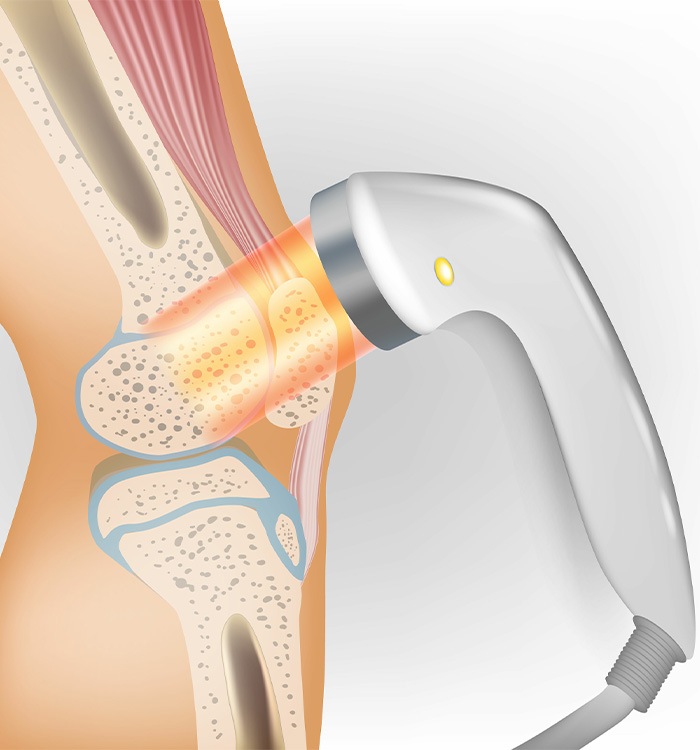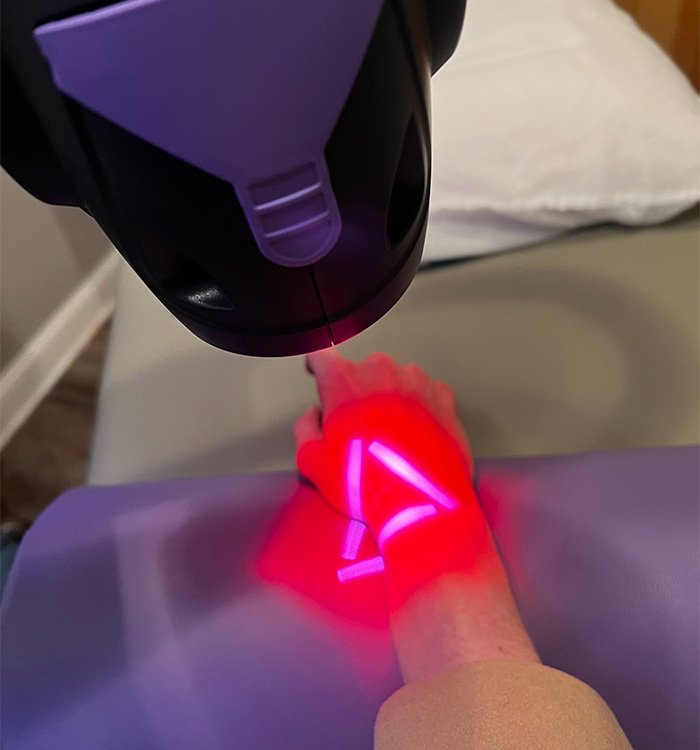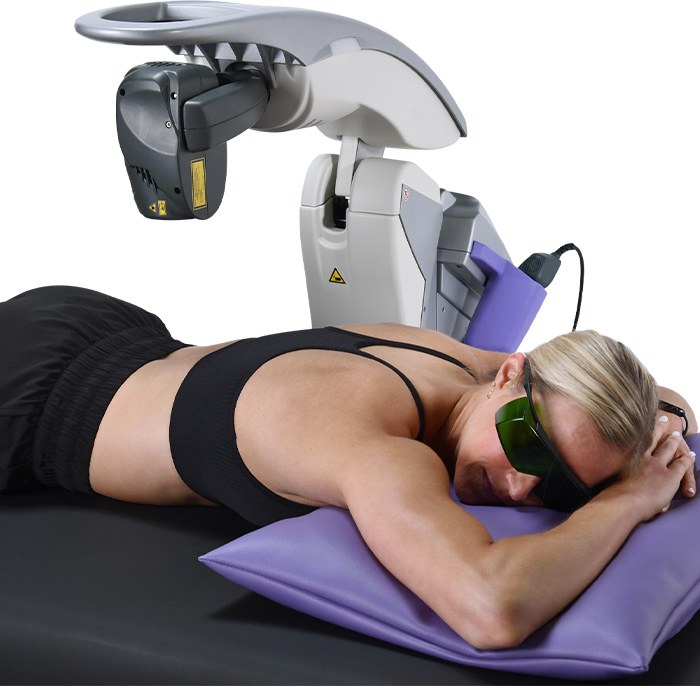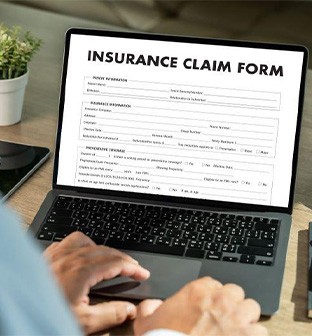
MLS Laser Therapy Asheville
Experience the Healing Power of Light
The FDA approved MLS M7 Robotic Laser, is a revolutionary, non-invasive treatment that uses light to heal damaged tissues, reduce inflammation, and provide meaningful pain relief. With over 85–90% of patients experiencing noticeable improvement, laser therapy is an effective and science-backed solution for a wide range of musculoskeletal issues. Continue reading below to learn more, or contact us to request an appointment. Our Asheville team looks forward to serving you!
How Does Laser Therapy Work?

MLS Laser Therapy uses light to wake up your body’s natural ability to heal itself.
Laser therapy is a treatment that uses three specific different wavelengths of therapeutic light to activate healing at a cellular level. When your body is inflamed or injured, normal cellular energy production is disrupted especially in the mitochondria (your cells’ energy centers).
Laser light therapy helps reverse that. The MLS laser penetrates deep into tissue, releasing nitric oxide from a key enzyme and allowing your mitochondria to resume healthy oxygen metabolism. This process increases cellular energy, promotes tissue repair, and reduces inflammation.
What Makes the MLS M7 Laser Different?

The MLS M7 robotic laser delivers two synchronized wavelengths of light. The 905 which focuses on reducing inflammation, and the 808 that stimulates cellular metabolism and promotes tissue regeneration. These work together to accelerate tissue repair, improve circulation, and support your body’s regenerative processes. Because it’s robotic, the MLS M7 can cover larger surface areas more precisely and consistently than traditional lasers. It’s especially effective for treating:
- Back, Neck and hip pain
- Arthritis and joint pain
- TMJ
- Sciatica
- Shoulder and elbow conditions
- Tendonitis, bursitis, and sprains
- Plantar fasciitis
- Sports injuries
- Edema
- Post surgery pain
What to Expect During Treatment

Laser therapy sessions are quick, gentle, and completely non-invasive. After we confirm you're a good candidate, you’ll simply relax while your MLS Laser technician places you in a comfortable position. Then, they will set up the laser and map out the treatment area to cover your area of concern and begin the procedure.
There’s no pain, just a soothing warmth as the light begins to work on a cellular level. Each session typically lasts 15-25 minutes, with no downtime afterward. Many patients start to feel relief within a few visits, with the best results seen after completing a series of treatments.
Benefits of MLS Laser Therapy

- Drug-free and non-surgical
- Safe and FDA-cleared
- Speeds up recovery
- Reduces inflammation
- Eases pain and stiffness
- Supports natural healing
Understanding the Cost of Laser Therapy

Even though laser therapy is an advanced treatment it is affordable for most patients!. When you call us or come in for a consultation, we can provide pricing information based on your unique situation. We will also be happy to help you understand your payment options, such as financing or credit cards. Additionally, we can provide documentation to assist you with insurance claims.

Factors That Can Affect the Cost of Laser Therapy
The cost of your laser therapy may be affected by:
- How many laser sessions you require. Your unique situation will determine how many times you need to visit us for laser therapy. Some patients notice significant benefits after just a few sessions, whereas others need a more extensive course of treatment. Logically, more laser sessions will incur higher total fees.
- Complementary treatment. Laser therapy is sometimes used alongside other treatments to optimize patient outcomes. Each treatment comes with its own price and will be billed accordingly.
- Other factors. The specific type of laser used, the cost of living in your local area, and other factors can all influence the total cost of your treatment.

Does Medical Insurance Cover Laser Therapy?
Some medical insurance plans cover laser therapy, while others do not. Here are a few important notes to keep in mind if you wish to use your benefits:
- You may need to seek preauthorization. Often, health insurance only covers services that they consider to be medically necessary. You may have to establish medical necessity before moving forward with treatment.
- Our team does not work with insurance. Many of the services we offer are not covered by insurance, so we do not participate in any plans. This stance helps us to provide the highest quality of care possible. However, we will still be happy to provide documentation that you can submit to your insurer so you can request reimbursement.

Other Options to Make Laser Therapy Affordable
Beyond insurance, there are other provisions that might make it easier to afford your laser therapy:
- Our practice works with Varidi, a third-party lender, to provide low-interest payment plans for patients. Applying is fast and easy, and most patients are deemed eligible for credit.
- Credit cards. Using your card to pay for treatment can help you to accumulate points and bonuses with the credit card company.
- HSAs and FSAs. In some cases, laser therapy may be an approved use of funds from healthcare savings accounts and flexible spending accounts.
Are you interested in learning more about the cost of laser therapy? Get in touch with our knowledgeable Asheville team today!
Laser Therapy FAQs
Who Is a Good Candidate for Laser Therapy?
Laser therapy can be used to address various types of aches and pains. Here is a list of some conditions that we might recommend it for:
- Strains and sprains
- Sports injuries
- Post-surgical pain
- Whiplash injuries
- Muscular back pain
- Cervical or lumbar radiculopathy
- Tendinitis
- Arthritis, including both osteoarthritis and rheumatoid arthritis
- Frozen shoulder
- Epicondylitis, including tennis elbow and golfer’s elbow
- Carpal tunnel syndrome
- Tendinopathy
- Temporomandibular joint disorder (also known as TMJ or TMD)
- Fibromyalgia
Laser therapy is safe for most patients. However, if you have certain conditions, such as pregnancy, we might want to explore alternative treatment options.
How Many Sessions of Laser Therapy Will I Need?
Dr. Pinkston designs treatment plans on a case-by-case basis. The nature and severity of your condition will play a role in determining how many laser sessions you need. Some patients start to notice a difference after just a few visits to our office, while others need a longer course of treatment. If you have a chronic condition, such as severe arthritis, you may need to visit us periodically to maintain your results.
For an initial course of laser treatment, we may recommend that you visit us 2 – 3 times per week.
How Much Does Laser Therapy Cost?
Due to its simple and non-invasive nature, laser therapy is affordable for most patients. We invite you to give us a call or request a consultation to learn more about pricing.
If your treatment is considered medically necessary according to your health insurance’s guidelines, your benefits might cover it. Although our practice does not work directly with insurance companies, we will be happy to provide documentation that you can submit to your insurance company.
Can Laser Therapy Cause Cancer?
Although the long-term effects of laser therapy have not been thoroughly studied, there are a few key facts that you should keep in mind:
- Laser therapy does not use ultraviolet light. Ultraviolet light is one type of energy emitted by the sun and tanning beds. Overexposure to it can damage DNA in skin cells, leading to cancerous growths. Since laser therapy does not use any UV light at all, there is nothing to indicate that it could cause skin cancer.
- Laser therapy is designed to promote healing at a cellular level. It stimulates natural repair mechanisms within the body and can lead to lasting pain relief from injuries and other musculoskeletal complaints. All available evidence indicates that it is good for you.
What Makes the MLS M7 Laser Different from Other Types of Lasers?
The MLS M7 laser (Multiwave Locked System laser therapy) utilizes the latest advancements in orthopedic laser therapy. Some of its outstanding features include:
- Advanced software that can optimize the consistency and effectiveness of treatment.
- A robotic head that can scan the treatment area to ensure consistent results.
- The use of dual wavelengths of light for deeper tissue penetration and more comprehensive results. The wavelengths are: 808 nm (Anti-edemic and Anti-inflammatory) and 905 nm (Analgesic)
- 50-watt peak power usage to enhance patient outcomes without compromising safety.
Is MLS Laser Therapy FDA approved?
Yes, this type of laser therapy is approved by the FDA as a safe and effective treatment for pain management, minimizing inflammation, edema, and accelerating healing.
What Is the Success Rate of MLS Laser Therapy?
Laser therapy is a highly effective treatment for those who follow their protocol. Studies show that 85%-90% of patients report positive outcomes.